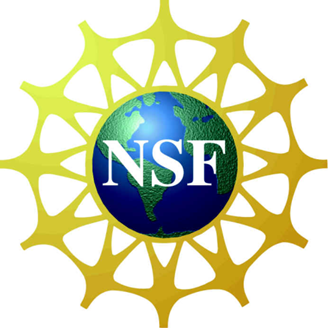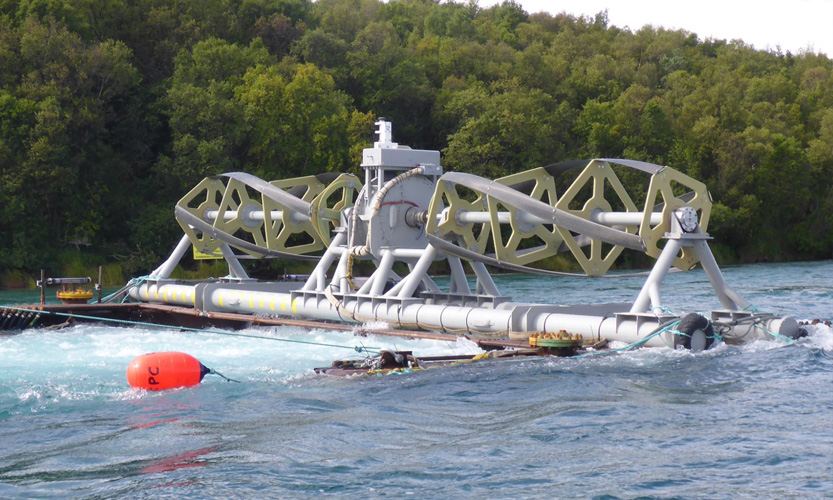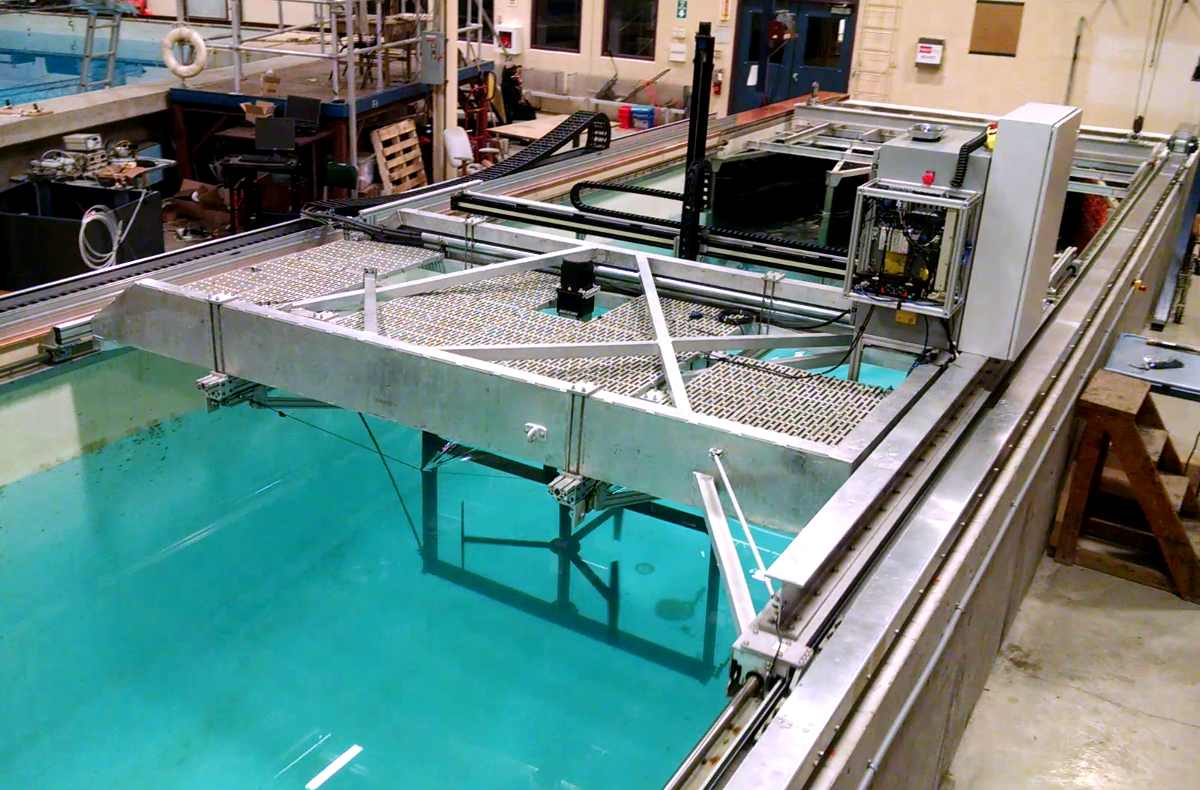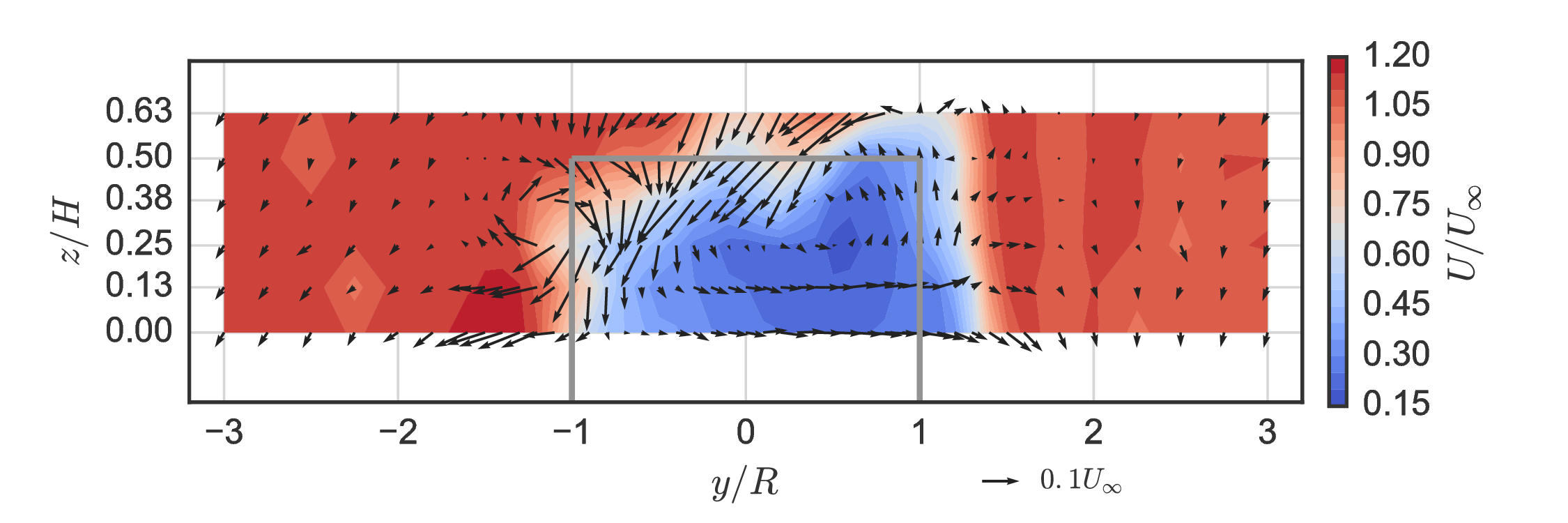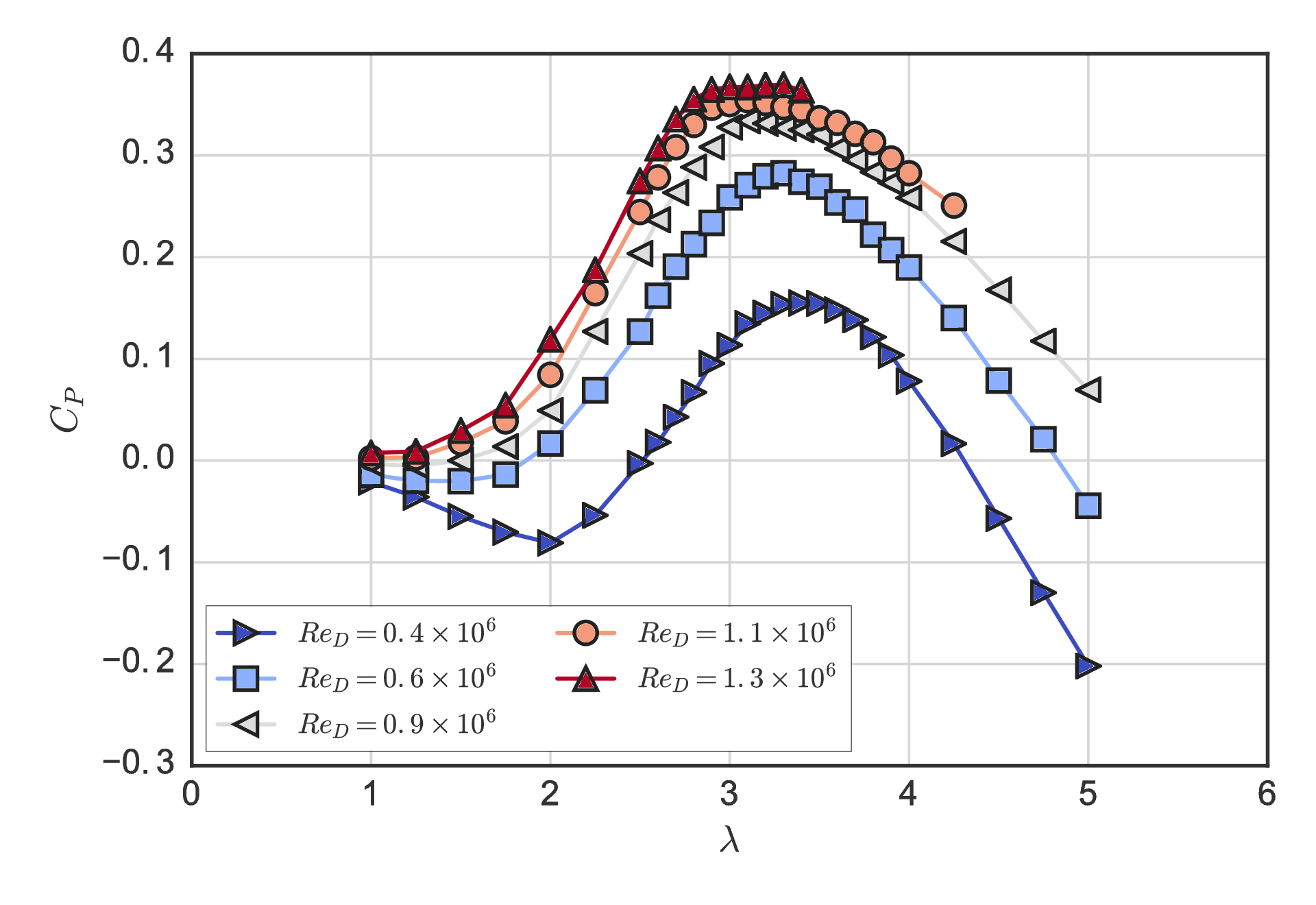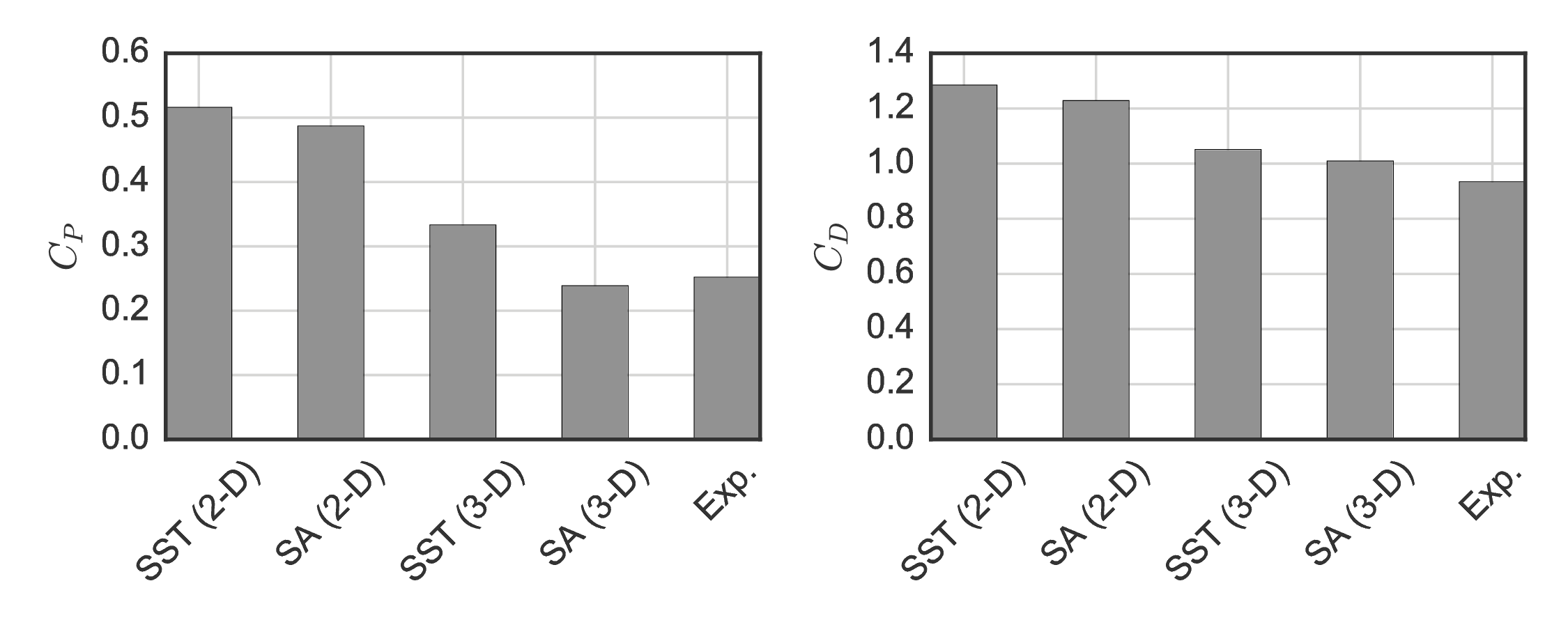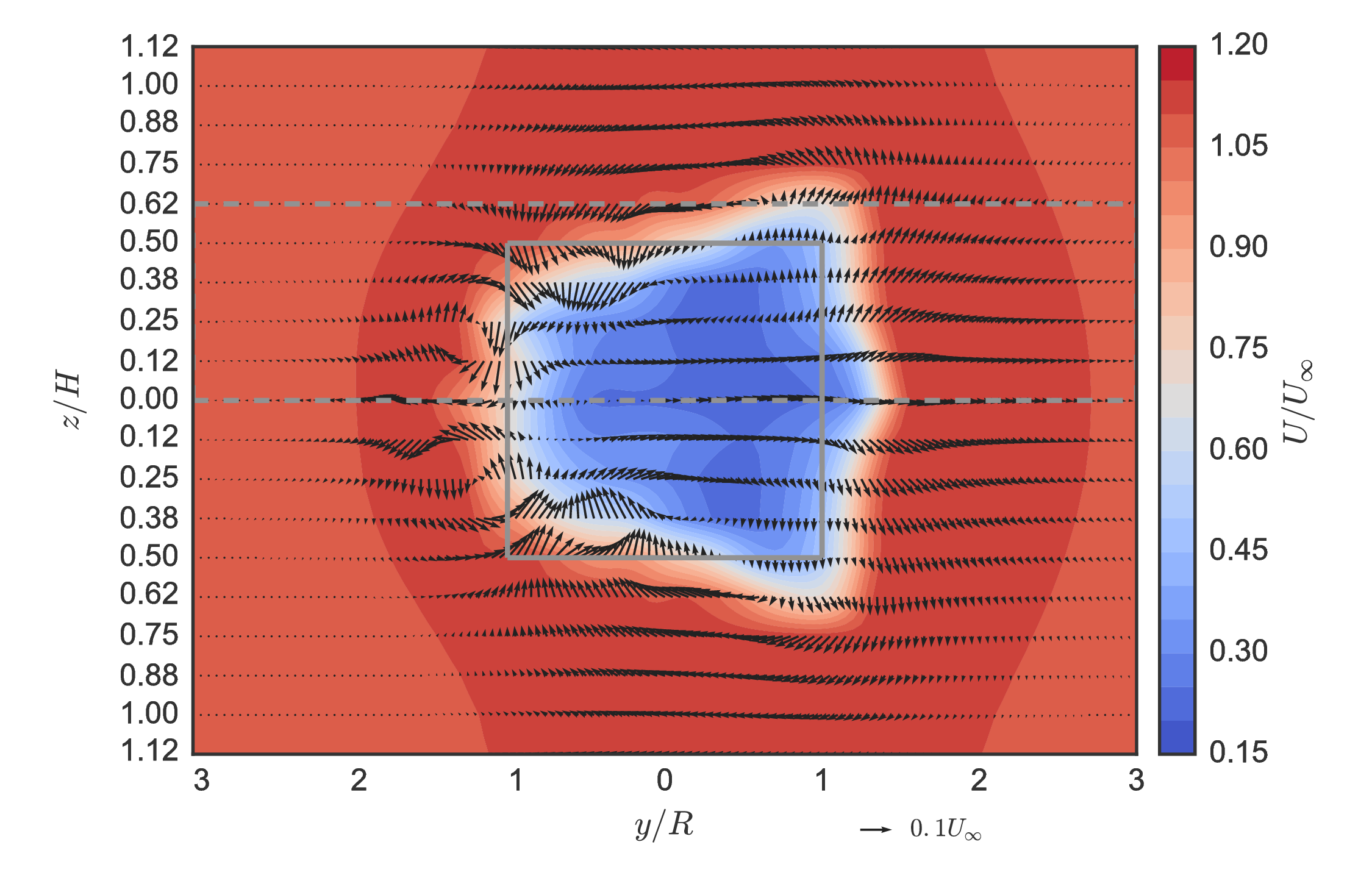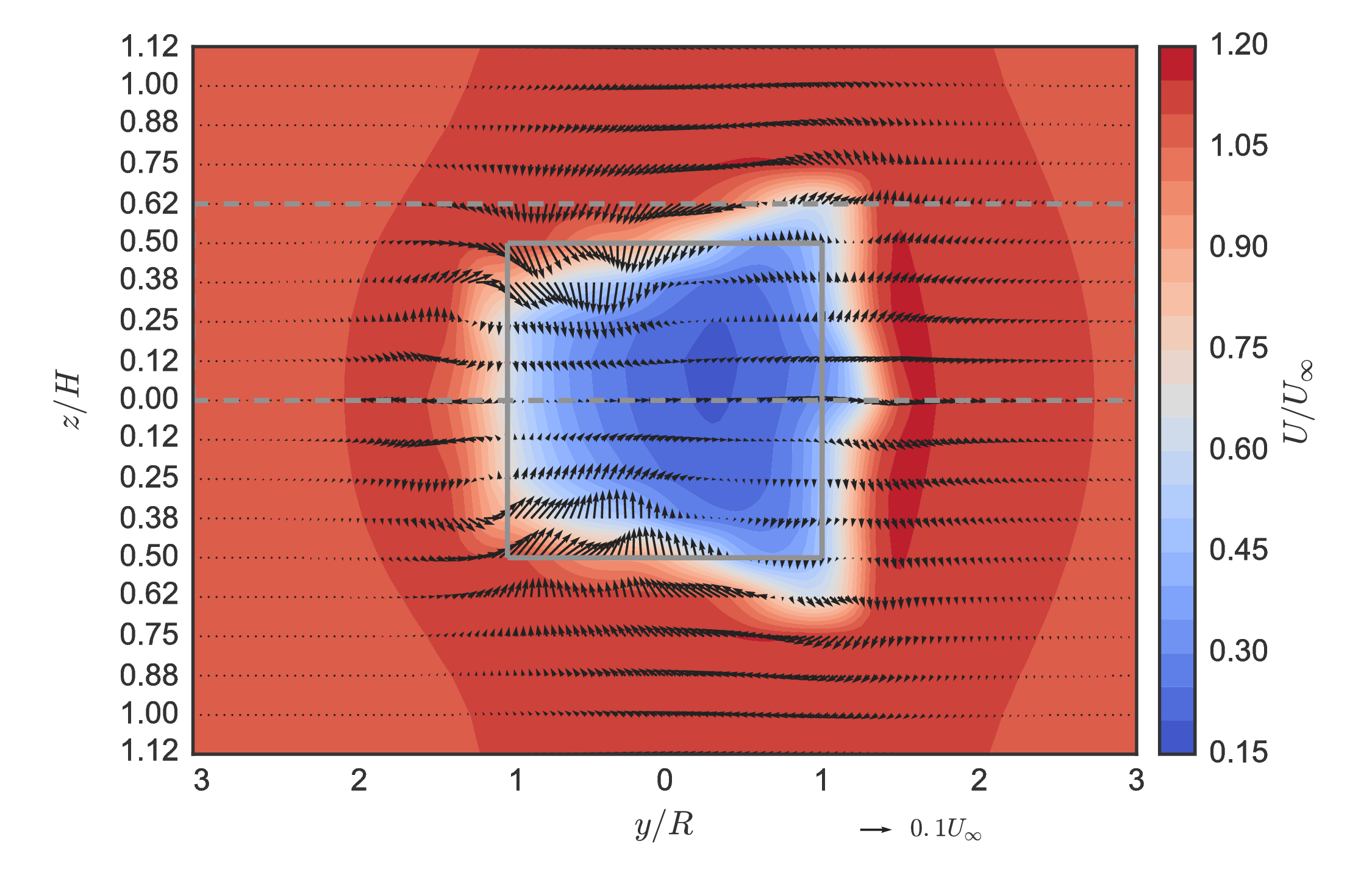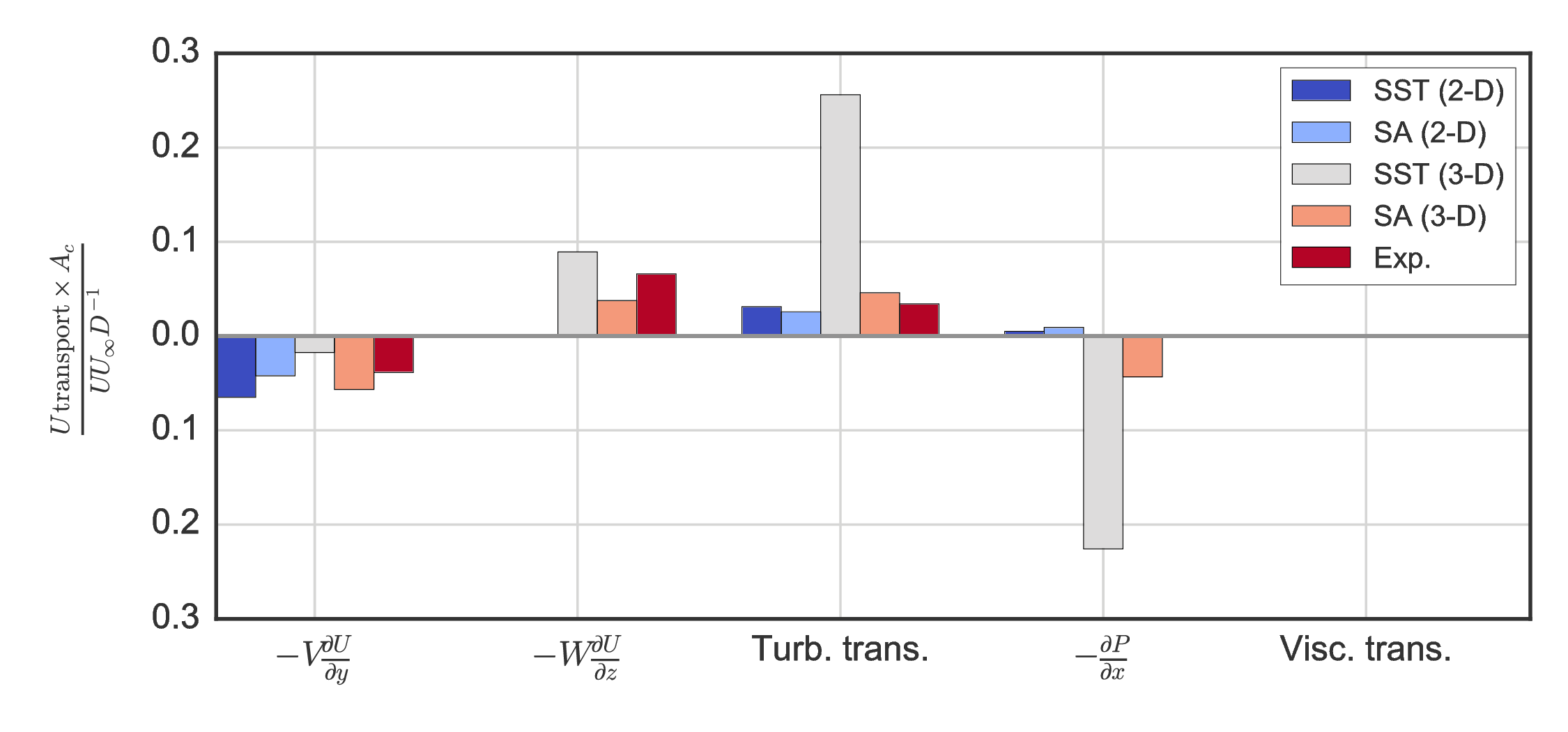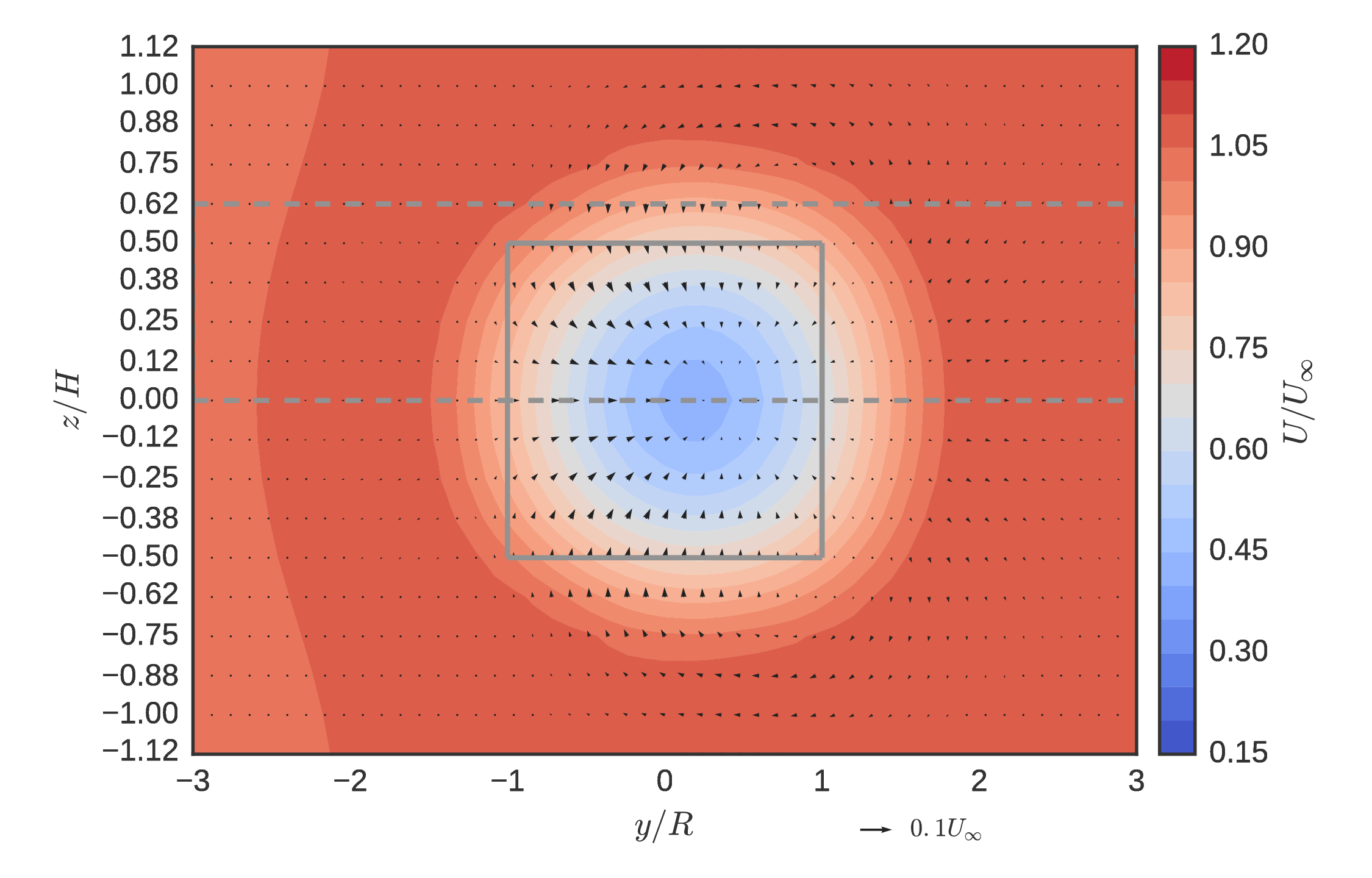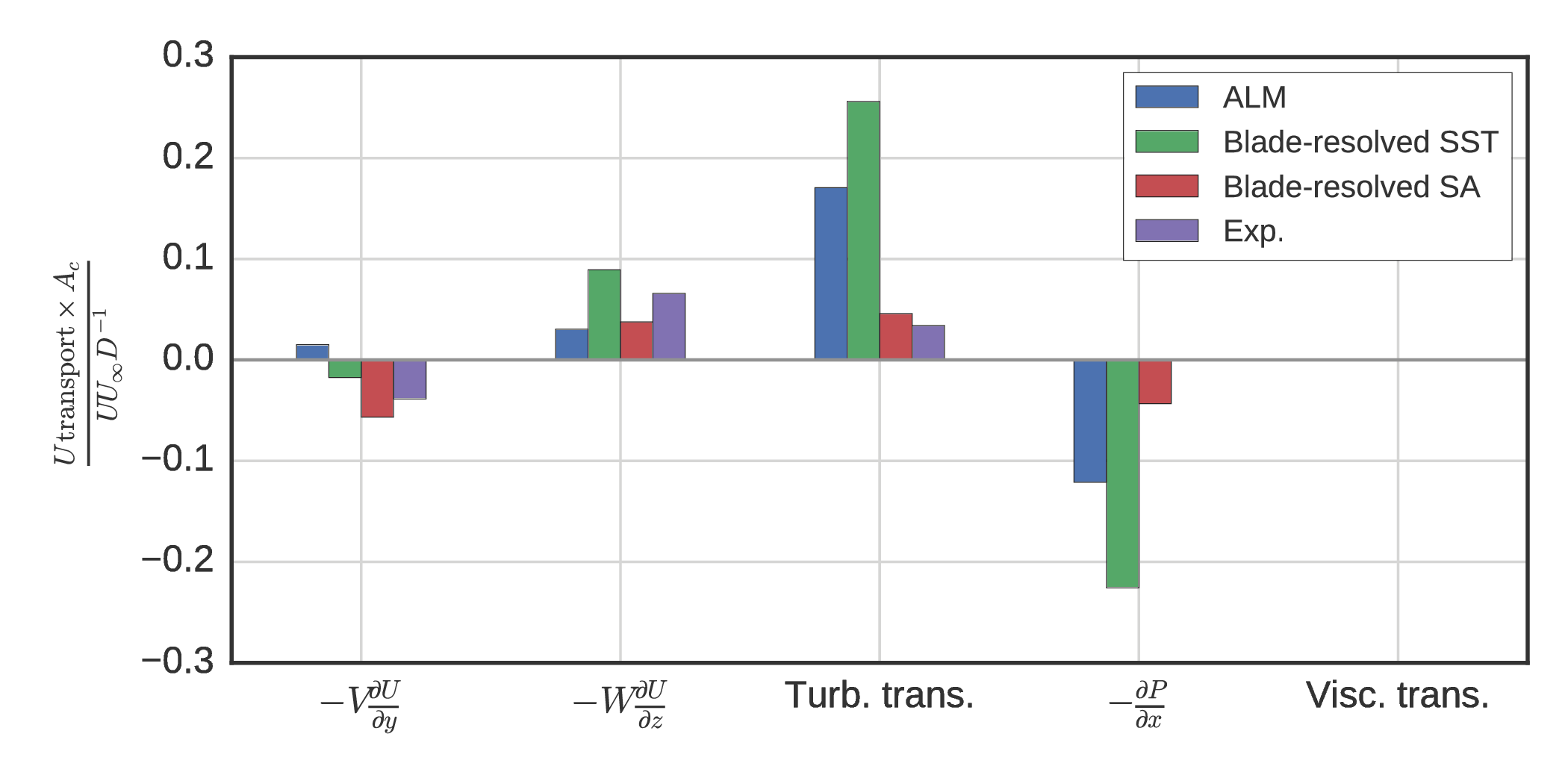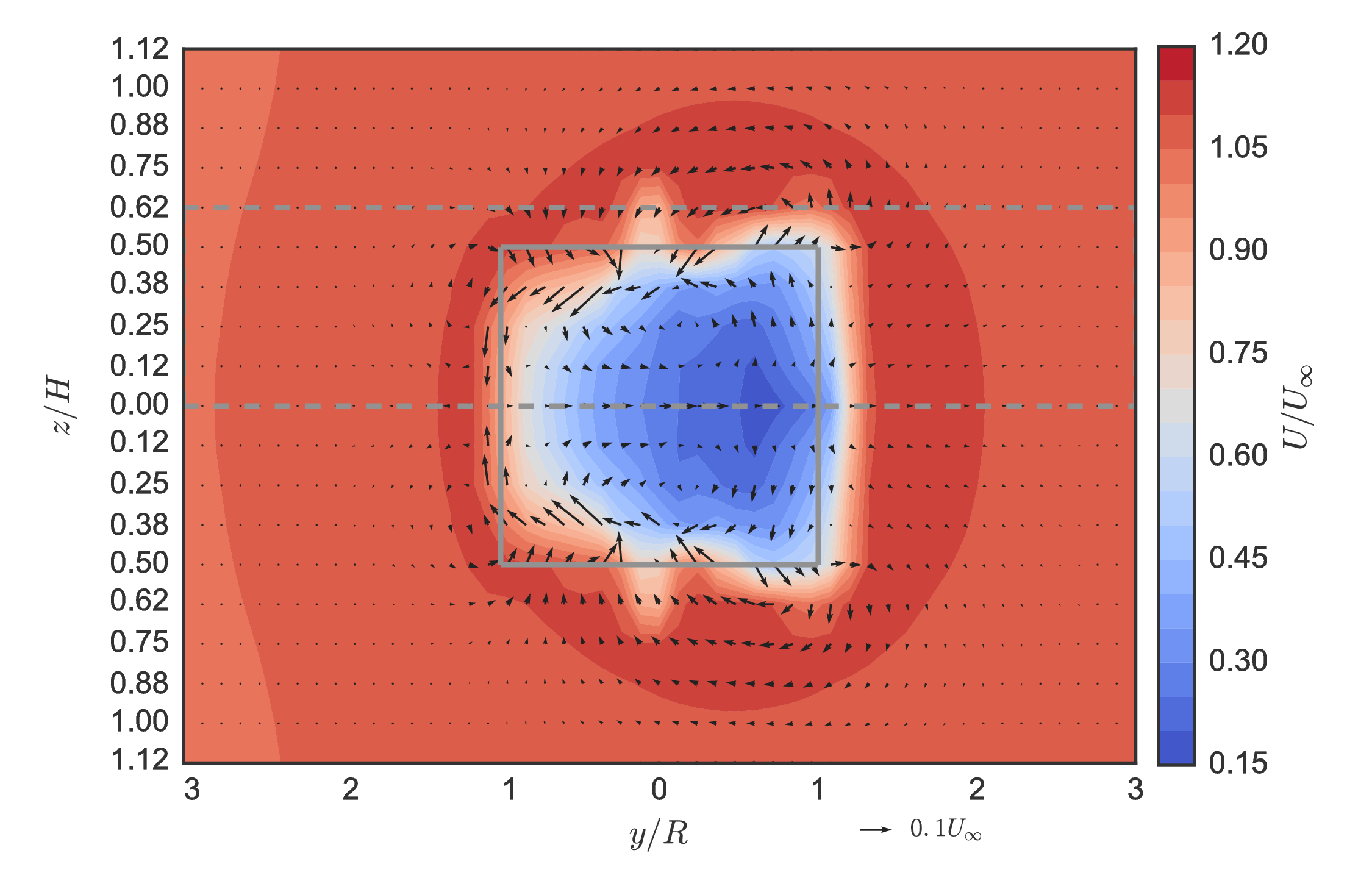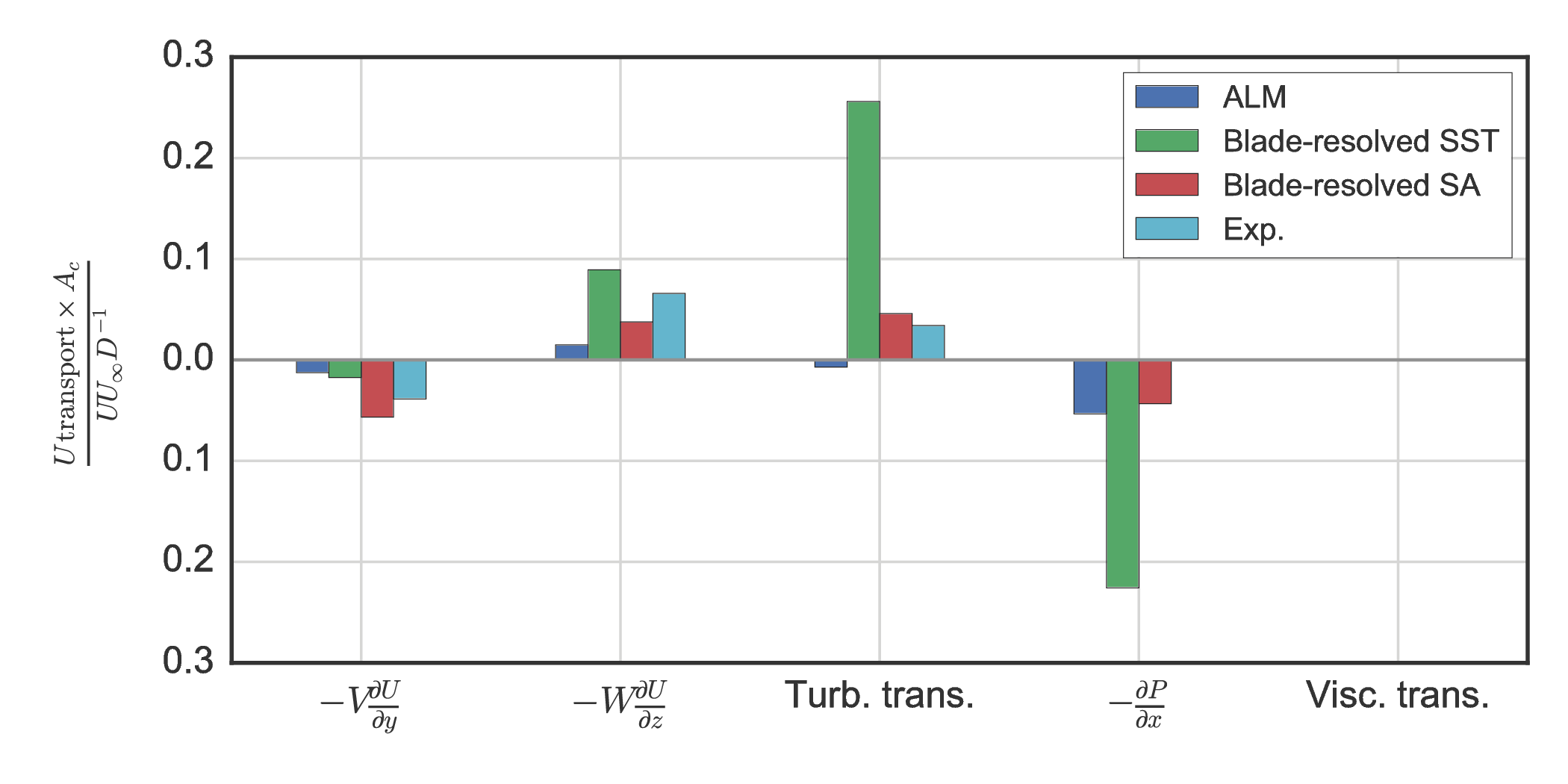What is a cross-flow turbine?¶
- Axis perpendicular to flow
- Some success in onshore wind
- Surpassed by HAWTs (AFTs) →
- Exaggerated power ratings
- Fatigue issues
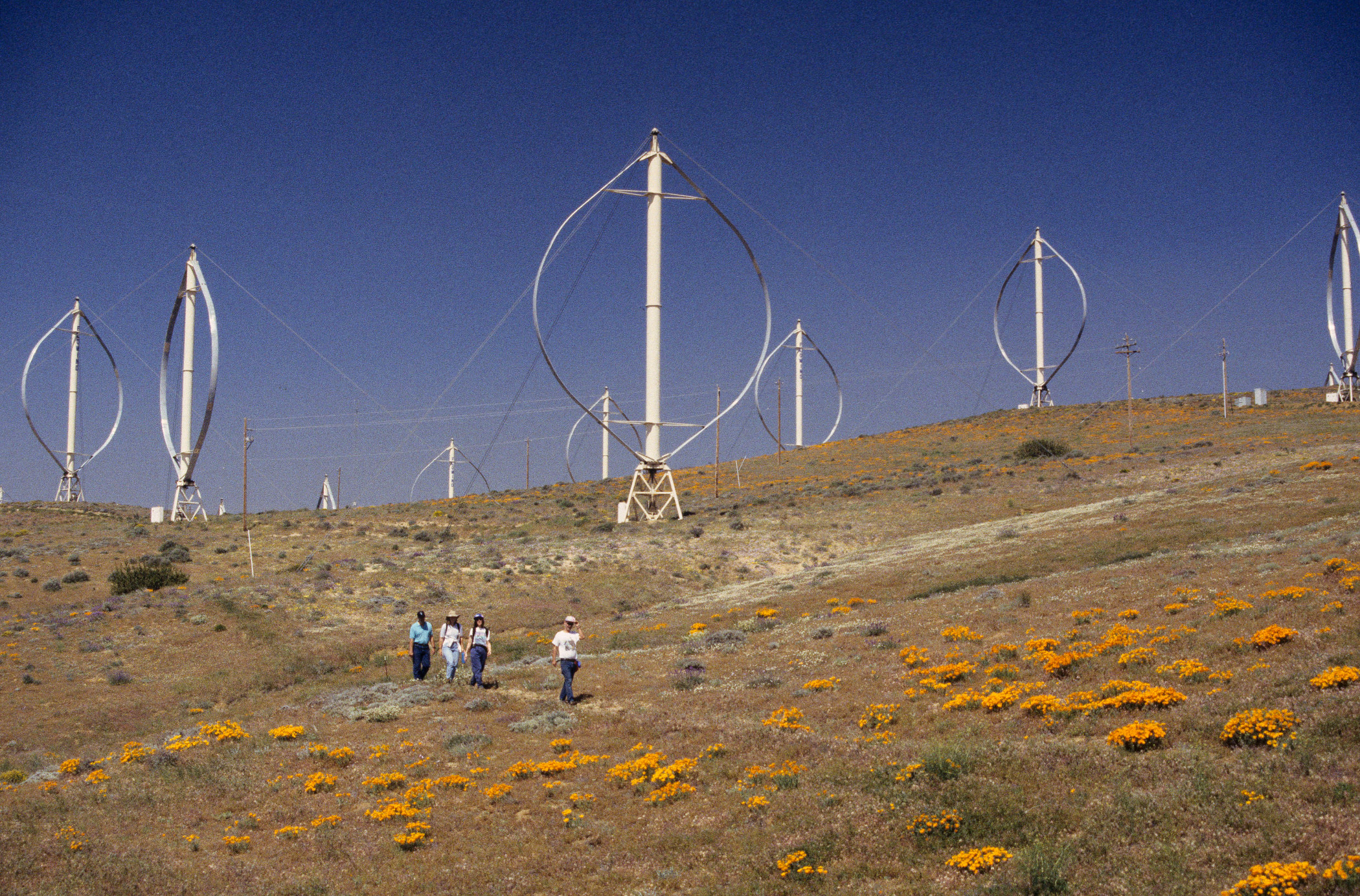
Left: Photo by Paul Gipe. All rights reserved. Upper right: Courtesy of Vestas Wind Systems A/S. Lower right: From Murray and Barone (2011).
Wind turbine arrays: Caltech FLOWE¶
Closely spaced VAWTs may achieve higher power output per unit land area compared to HAWTs. Note the rotors shown here are also high solidity.
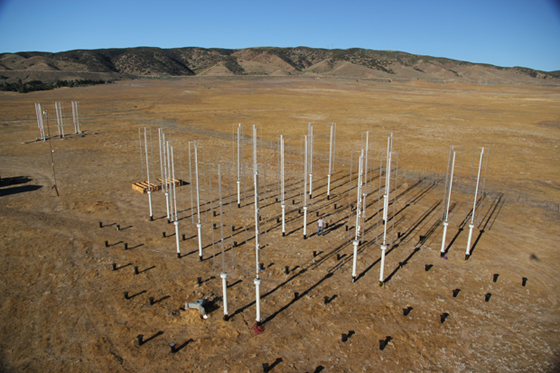
From flowe.caltech.edu.
Blade element theory¶
Assume kinematics and dynamics act on blade section at one point.
import warnings
warnings.filterwarnings("ignore")
os.chdir(os.path.join(os.path.expanduser("~"), "Google Drive", "Research", "CFT-vectors"))
import cft_vectors
fig, ax = plt.subplots(figsize=(15, 15))
fontsize = plt.rcParams["font.size"]
with plt.rc_context({"font.size": 1.5*fontsize}):
cft_vectors.plot_diagram(fig, ax, theta_deg=52, axis="off", label=True)
os.chdir(talk_dir)
Blade element theory¶
In an idealized case, CFT is unsteady, often $\alpha_\max \gt \alpha_{\mathrm{ss}}$. Not so for AFT.
Quantifying unsteadiness¶
Reduced frequency:
$$ k = \frac{\omega c}{2 U_\infty} = \frac{\lambda c}{2R} $$$$ \lambda = \frac{\omega R}{U_\infty} $$Unsteady effects significant for $k > 0.05$, dominant for $k \ge 0.2$ [1].
| Rotor | $ c/R $ | $\lambda$ | $k$ |
|---|---|---|---|
| Sandia 34 m Darrieus | 0.05 | 6 | 0.16 |
| Hypothetical MHK | 0.25 | 2 | 0.25 |
MHK rotor blades see approximately one order of magnitude higher torque vs. wind.
[1] Leishman (2006) "Principles of Helicopter Aerodynamics", Cambridge.
Research objectives¶
- Produce model validation datasets for higher solidity CFTs
- Investigate near-wake, especially recovery
- Relevant to array design
- Evaluate Navier–Stokes based models (blade-resolved and parameterized) for predicting performance and wake characteristics
- Lower fidelity models fail for higher $c/R$
- Computing power has advanced tremendously since the Darrieus VAWT R&D
Test bed instrumentation¶
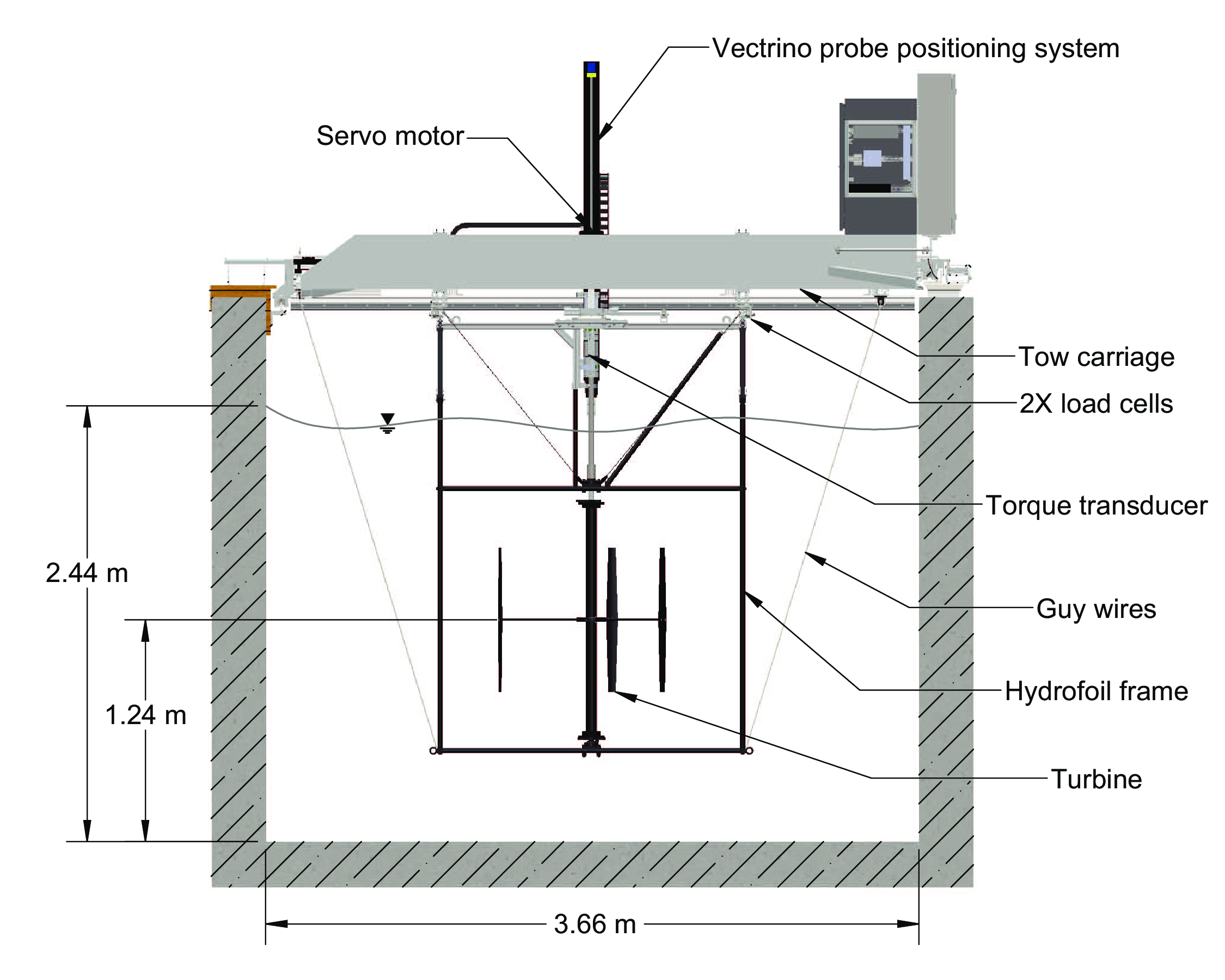
Wake measurement instrumentation¶
- Nortek Vectrino+ acoustic Doppler velocimeter (ADV)
- $y$–$z$ traversing carriage with motion control integration
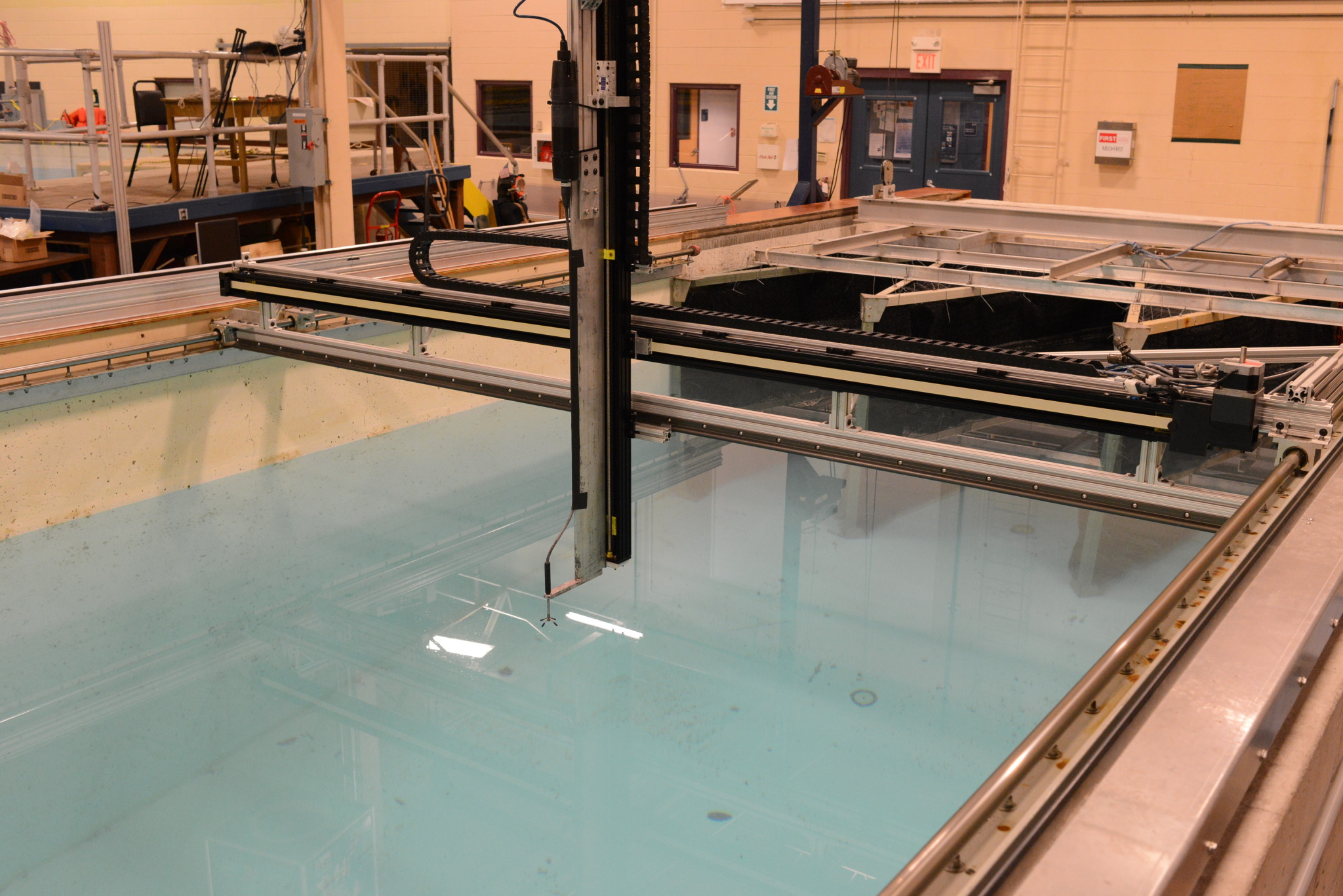
Automation¶
Operation¶
UNH-RVAT baseline experiments¶
- Simple geometry
- NACA 0020 foils
- High solidity $c/R = 0.28$
- $U_\infty = 1$ m/s
- Characterize performance
- Near-wake dynamics
- Open dataset
Bachant, P., and Wosnik, M. (2015) "Characterising the near-wake of a cross-flow turbine", Journal of Turbulence, 16, 392–410.
Bachant, P., and Wosnik, M. (2014) "UNH-RVAT baseline performance and near-wake measurements: Reduced dataset and processing code", Figshare, DOI: 10.6084/m9.figshare.1080781.
UNH-RVAT baseline performance¶
# Generate figures from the experiments by their own methods
os.chdir("C:/Users/Pete/Research/Experiments/RVAT baseline")
import pyrvatbl.plotting as rvat_baseline
fig, (ax1, ax2) = plt.subplots(figsize=(15, 6), nrows=1, ncols=2)
rvat_baseline.plot_cp(ax1)
rvat_baseline.plot_cd(ax2, color=sns.color_palette()[2])
fig.tight_layout()
os.chdir(talk_dir)
Note: Overall rotor drag (sometimes called thrust) coefficient $C_D$ is different from blade element drag coefficient $C_d$.
Baseline wake measurements $(x/D=1)$¶
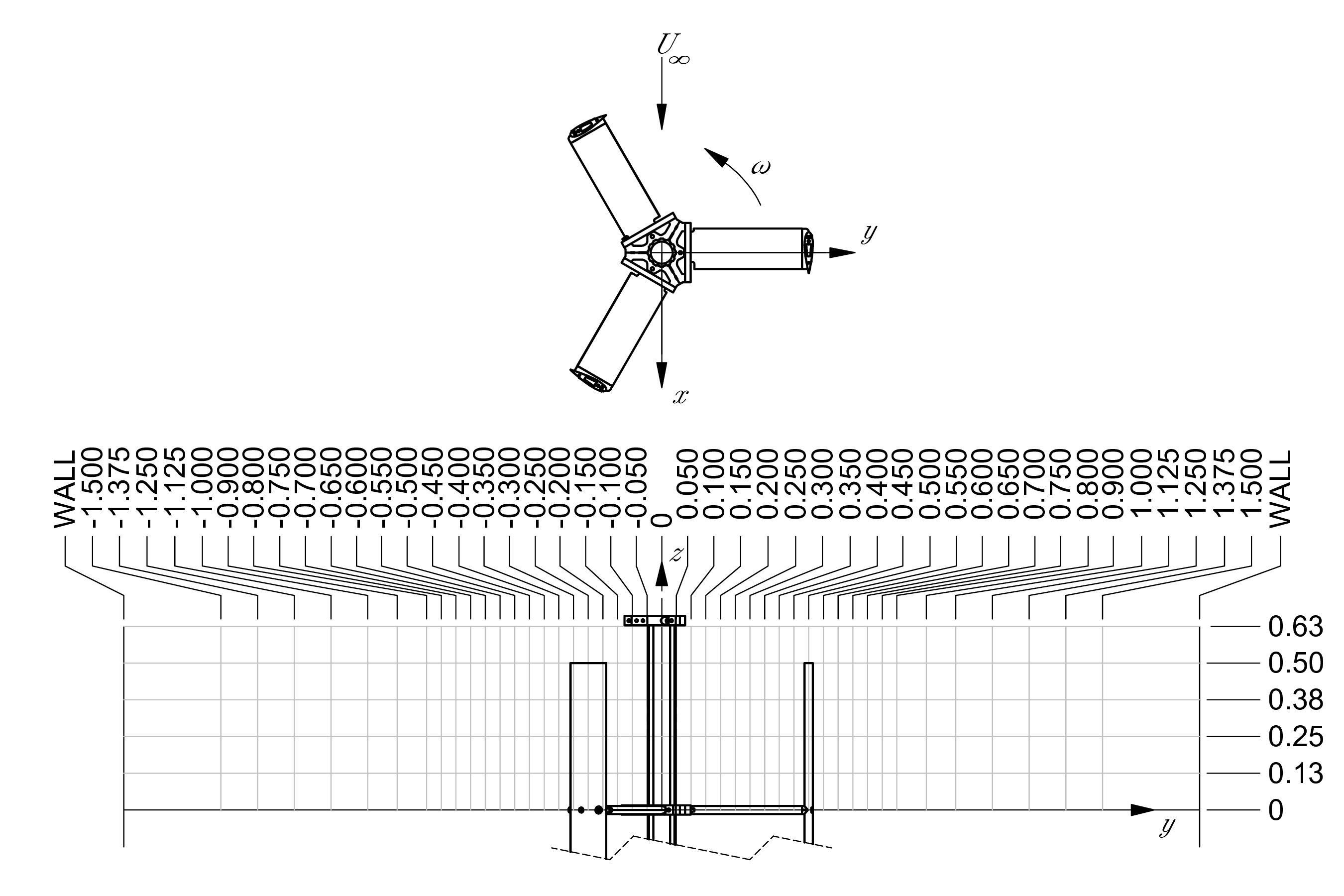
Unique mean "doublet" flow created by blade tip vortices inducing vertical velocity towards $x$–$y$ center plane.
Mean momentum transport¶
Rearrange RANS to isolate streamwise partial derivative:
$$ \begin{split} \frac{\partial U}{\partial x} = \frac{1}{U} \bigg{[} & - V\frac{\partial U}{\partial y} - W\frac{\partial U}{\partial z} \\ & -\frac{1}{\rho}\frac{\partial P}{\partial x} \\ & - \frac{\partial}{\partial x} \overline{u'u'} - \frac{\partial}{\partial y} \overline{u'v'} - \frac{\partial}{\partial z} \overline{u'w'} \\ & + \nu\left(\frac{\partial^2 U}{\partial x^2} + \frac{\partial^2 U}{\partial y^2} + \frac{\partial^2 U}{\partial z^2} \right) \bigg{]} \end{split} $$Mean momentum transport¶
Weighted averages at $x/D=1$:
os.chdir("C:/Users/Pete/Research/Experiments/RVAT baseline")
import pyrvatbl.plotting as rvat_baseline
rvat_baseline.plotwake("mombargraph", scale=1.8, barcolor=None)
plt.grid(True)
Mean advection in AFT wake due to axisymmetric swirl would cancel itself out.
UNH-RVAT Reynolds number dependence¶
Are our results relevant to full scale?
$$ Re_l = \frac{Ul}{\nu} $$How inexpensive (small, slow) can experiments get?
Bachant, P., and Wosnik, M. (2016) "Effects of Reynolds Number on the Energy Conversion and Near-Wake Dynamics of a High Solidity Vertical-Axis Cross-Flow Turbine", Energies, 9.
Bachant, P., and Wosnik, M. (2016) "UNH-RVAT Reynolds number dependence experiment: Reduced dataset and processing code", Figshare, DOI: 10.6084/m9.figshare.1286960.
UNH-RVAT Reynolds number dependence¶
os.chdir(rvat_re_dep_dir)
import pyrvatrd.plotting as rvat_re_dep
fig, (ax1, ax2) = plt.subplots(figsize=(16, 6.5), nrows=1, ncols=2)
rvat_re_dep.plot_perf_curves(ax1, ax2)
fig.tight_layout()
os.chdir(talk_dir)
Note effects of stall delay at lower $\lambda$, where angle of attack amplitude is greater.
Reynolds number dependence at $\lambda = 1.9$¶
os.chdir(rvat_re_dep_dir)
import pyrvatrd.plotting as rvat_re_dep
fontsize = plt.rcParams["font.size"]
with plt.rc_context({"axes.formatter.use_mathtext": True, "font.size": fontsize*1.65/1.5}):
fig, (ax1, ax2) = plt.subplots(figsize=(14, 6), nrows=1, ncols=2)
rvat_re_dep.plot_perf_re_dep(ax1, ax2, errorbars=True, label_subplots=False)
fig.tight_layout()
os.chdir(talk_dir)
Threshold corresponds to blade boundary layer transition to turbulence, which delays separation to higher angles of attack.
$$ Fr = \frac{U_\infty}{\sqrt{gh_{\mathrm{tip}}}} = 0.1 \text{ to } 0.5 $$Wake transport totals¶
os.chdir(rvat_re_dep_dir)
import pyrvatrd.plotting as rvat_re_dep
fig, ax = plt.subplots()
with plt.rc_context({"axes.formatter.use_mathtext": True}):
rvat_re_dep.plot_wake_trans_totals(ax)
fig.tight_layout()
Similar threshold $Re$ as for $C_P$ → Low $Re$ physical model array studies may overpredict power of downstream turbines
DOE/SNL Reference Model 2 (RM2) experiments¶
DOE Reference Models: Open designs for standardized development and validation
Measured performance, $Re$-dependence, near-wake, strut drag, with 1:6 scale tapered-H rotor: NACA 0021 profiles, $c/R = 0.07$–$0.12$
Unique geometry for testing predictive robustness
Bachant, P., Gunawan, B., Wosnik, M., and Neary, V.S. (2016) "UNH RM2 tow tank experiment: Reduced dataset and processing code", Figshare, DOI: 10.6084/m9.figshare.1373899.
RM2 performance $Re$-dependence at $\lambda = 3.1$¶
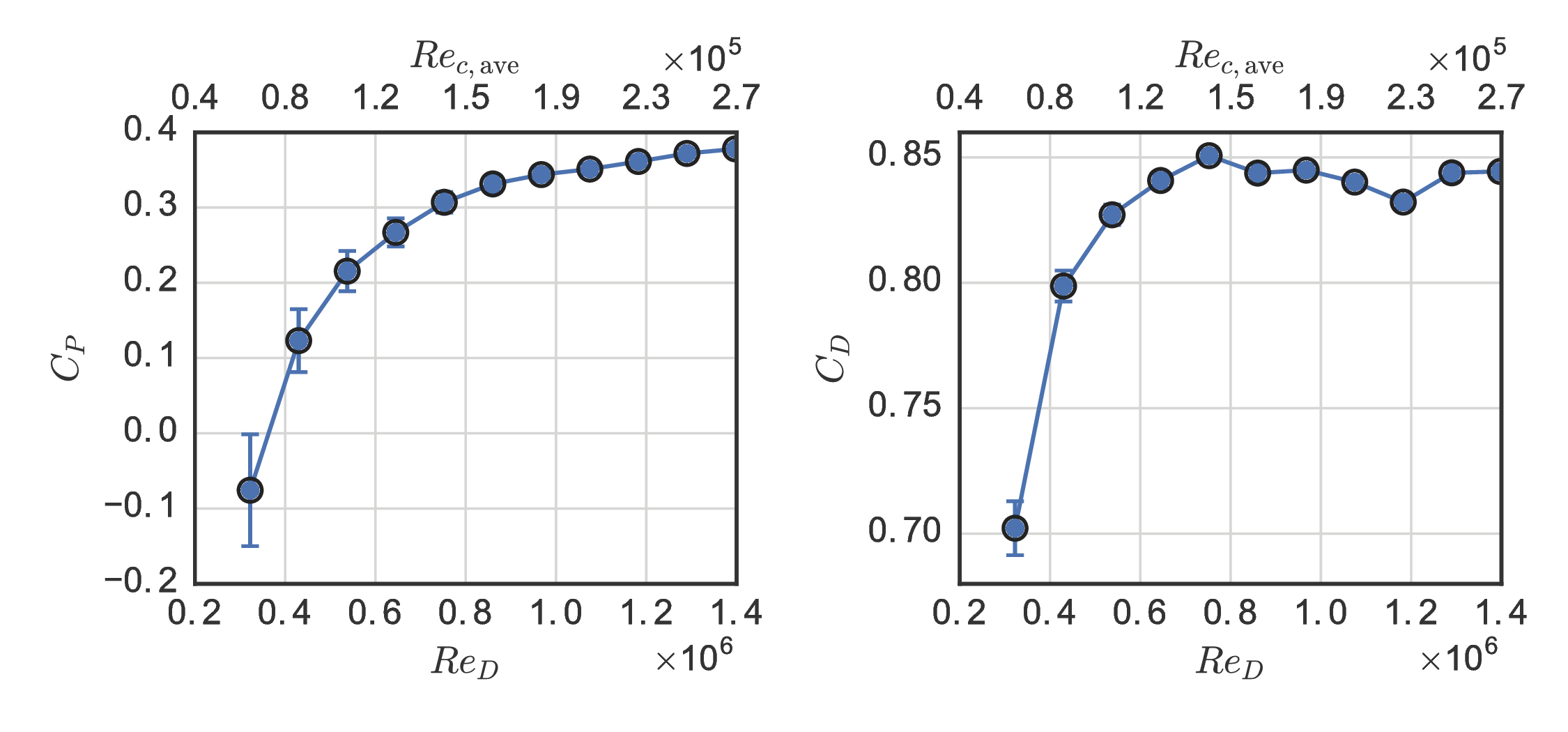
Retains weak $Re$-dependence → lower $c/R$ or virtual camber
UNH-RVAT blade-resolved RANS¶
- Simulate baseline with OpenFOAM
- Need to resolve the boundary layer
- Separation
- Transition?
- Turbulence models (eddy viscosity)
- $k$–$\omega$ SST
- Spalart–Allmaras
- 2-D: $\sim 0.1$ CPU hours per simulated second
- 3-D: $\sim 10^3$ CPU hours per simulated second
- HPC required: significant investment
- 192 cores on SNL Red Mesa cluster
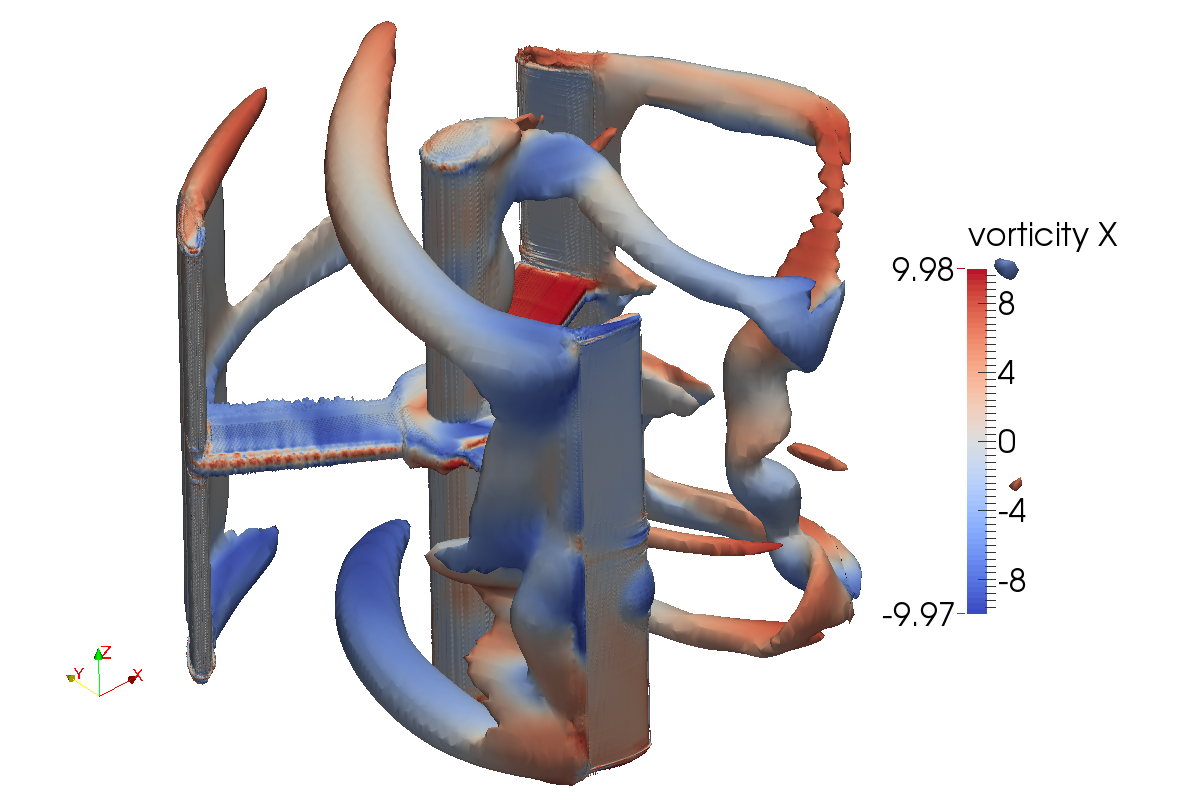
Mesh topology overview¶
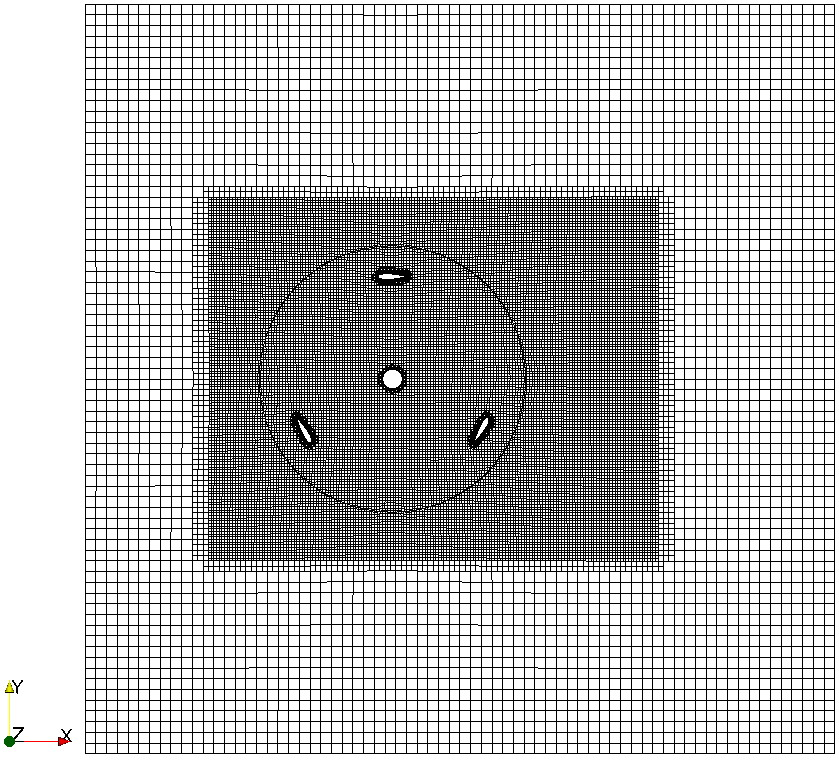
Near-wall blade mesh¶
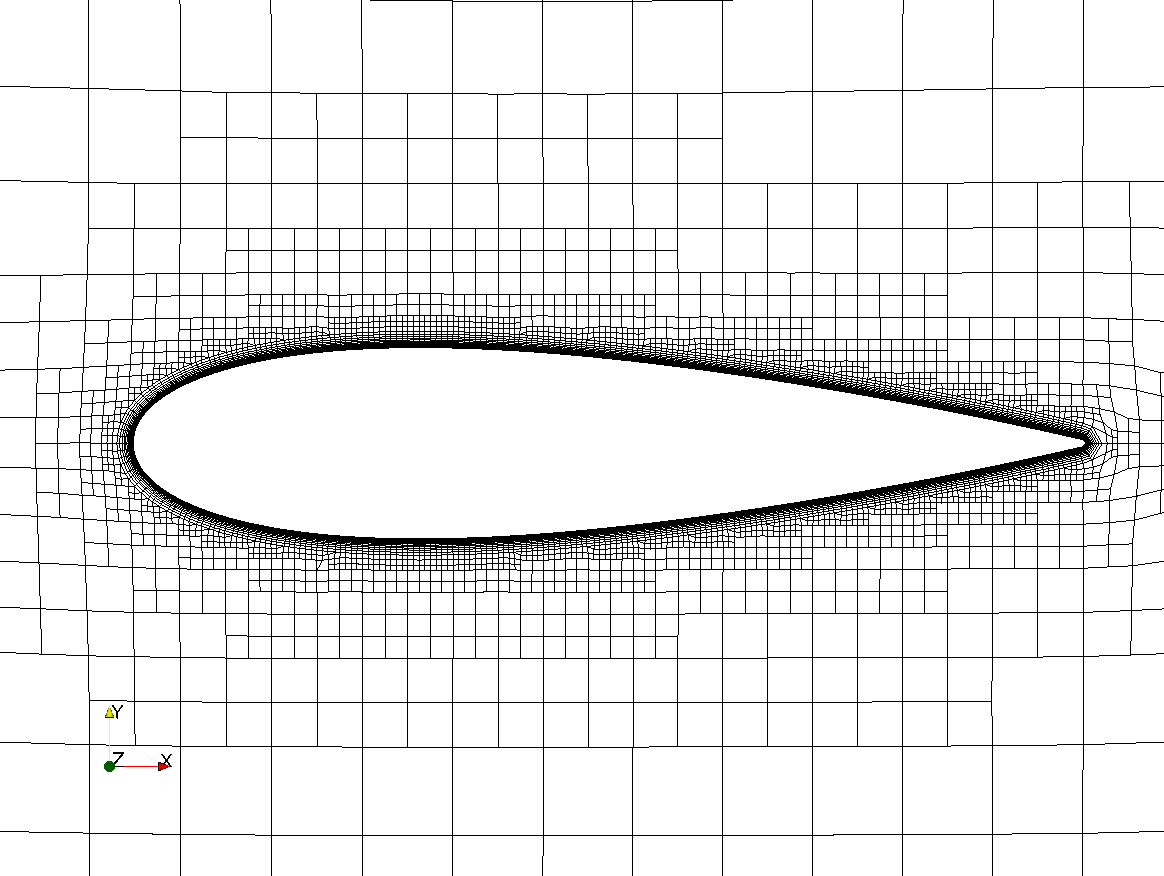
Verification (2-D)¶
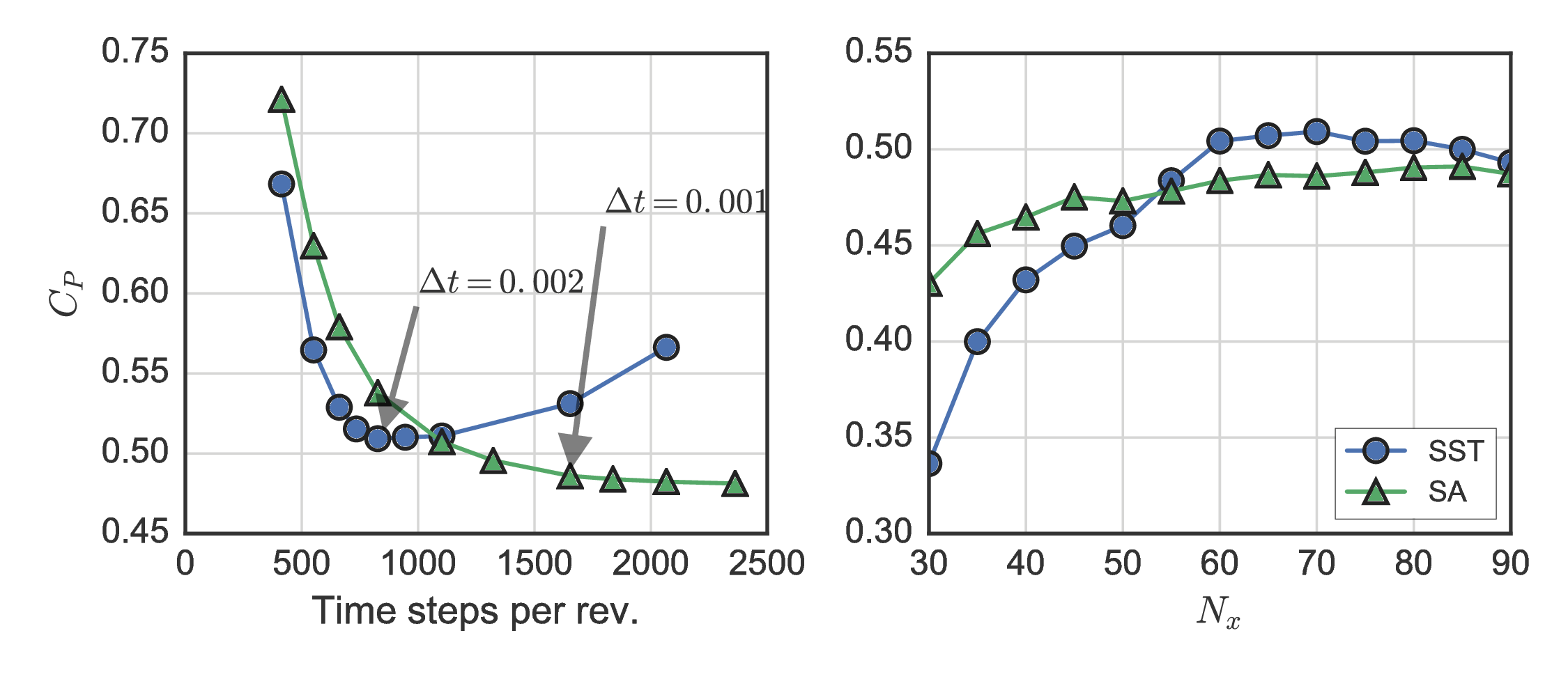
Spalart–Allmaras model showed more well-behaved grid convergence. Relative minimum chosen for SST $\Delta t$. $N_x = 70$ chosen for both models.
Actuator line modeling¶
- Developed by Sorensen and Shen (2002)
- Blade element method coupled with Navier–Stokes
- Save computational resources
- No finely resolved blade boundary layers
- No complicated meshing
- No mesh motion
- Current state-of-the-art for HAWT array modeling
- Has only been investigated with LES for a 2-D low-$Re$ CFT by Shamsoddin and Porte-Agel (2014)
- No performance predictions reported
- Closed source
ALM blade element discretization¶
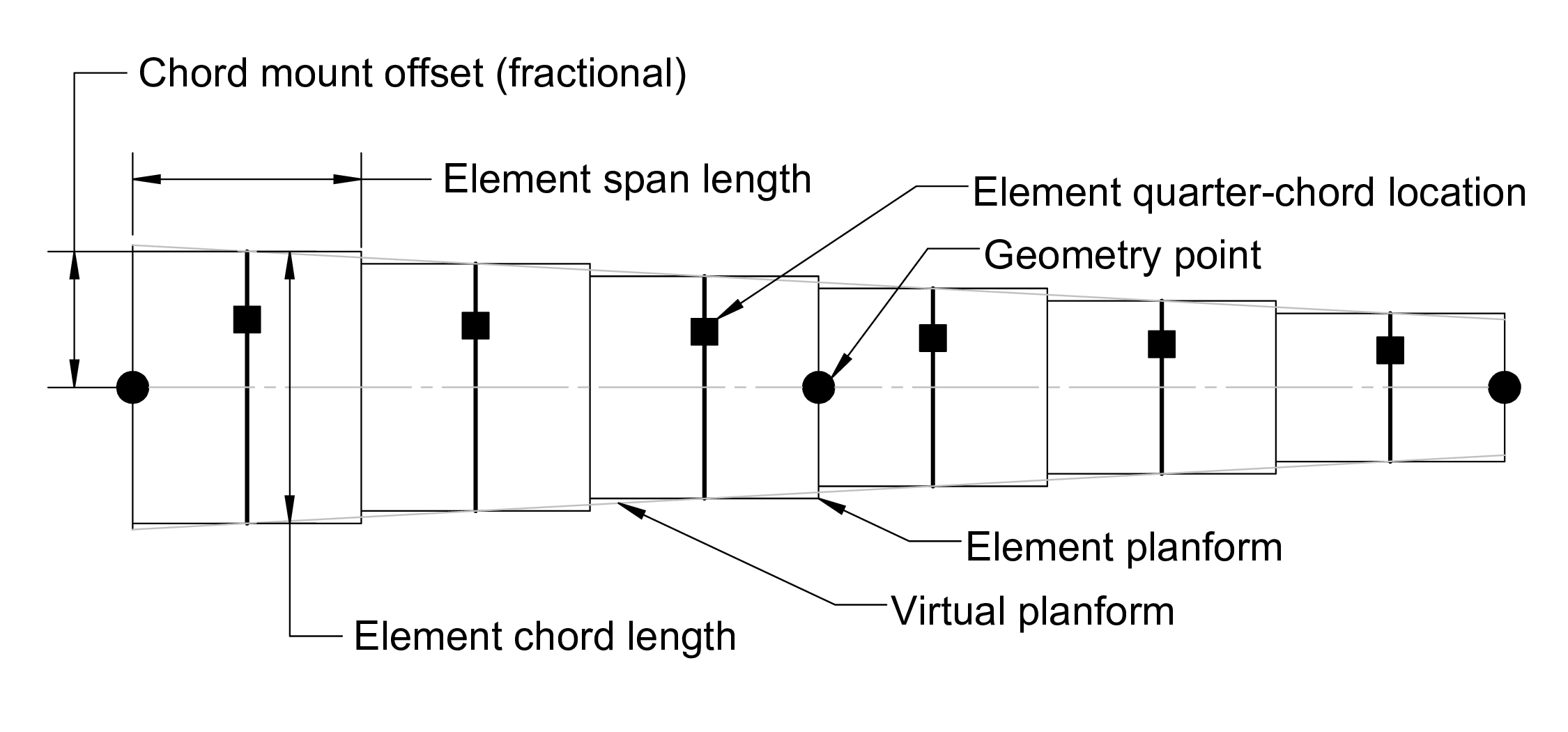
Computing blade loading¶
Inflow velocity from Navier–Stokes solver rather than via simple momentum, potential flow (vortex method).
$$ F_l = \frac{1}{2} \rho A_p C_l | U_{\mathrm{rel}} |^2 \, \, \, \, \, \, \, \, \, F_d = \frac{1}{2} \rho A_p C_d | U_{\mathrm{rel}} |^2 $$import warnings
warnings.filterwarnings("ignore")
os.chdir(os.path.join(os.path.expanduser("~"), "Google Drive", "Research", "CFT-vectors"))
import cft_vectors
fig, ax = plt.subplots(figsize=(13, 13))
fontsize = plt.rcParams["font.size"]
with plt.rc_context({"font.size": 1.4*fontsize}):
cft_vectors.plot_diagram(fig, ax, theta_deg=52, axis="off", label=True)
os.chdir(talk_dir)
Dynamic stall modeling¶
From Leishman and Beddoes (1989)
Leishman–Beddoes semi-empirical dynamic stall model based on lags to angle of attack, separation point, vortex lift, replicating "hysteresis loop."
Flow field coupling¶
AL force added to Navier–Stokes as body force source term:
$$ \frac{\partial \vec{u}}{\partial t} + \vec{u} \cdot \nabla \vec{u} = -\frac{1}{\rho}\nabla p + \nabla^2 \vec{u} + \boxed{\vec{f}} $$Force is smoothed outwards with a spherical Gaussian function:
Gaussian width mainly determined by local mesh size: $\approx 2 \Delta x$ (Troldborg, 2008) $\approx 2 \times 2 \sqrt[3] V_{\mathrm{cell}}$
Implementation¶
OpenFOAM extension library using fvOptions generic mechanism for adding sources at run time:
// Solve the Momentum equation
tmp<fvVectorMatrix> UEqn
(
fvm::ddt(U)
+ fvm::div(phi, U)
+ turbulence->divDevReff(U)
==
fvOptions(U)
);
Leverage existing solvers, parallelization, turbulence models. No wheel reinvention.
Developed openly on GitHub: https://github.com/turbinesFoam/turbinesFoam
UNH-RVAT and RM2 actuator line simulations¶
- Leishman–Beddoes DS model modified by Sheng et al. (2008)
- Flow curvature correction from Goude (2012)
- Lifting line based end effects model (not used for RM2)
- Added mass correction from Strickland et al. (1981)
- NACA 0021 static coefficients from Sheldahl and Klimas (1981)
- Major weakness of BE methods: Need static data, which is surprisingly hard to find
- Standard $k$–$\epsilon$ RANS model (eddy viscosity)
ALM mesh¶
Similar domain and BCs as 3-D blade-resolved case
$\sim 10^4$ lower computational effort with 3-D RANS compared to blade-resolved → Easily run on laptop
ALM verification¶
UNH-RVAT
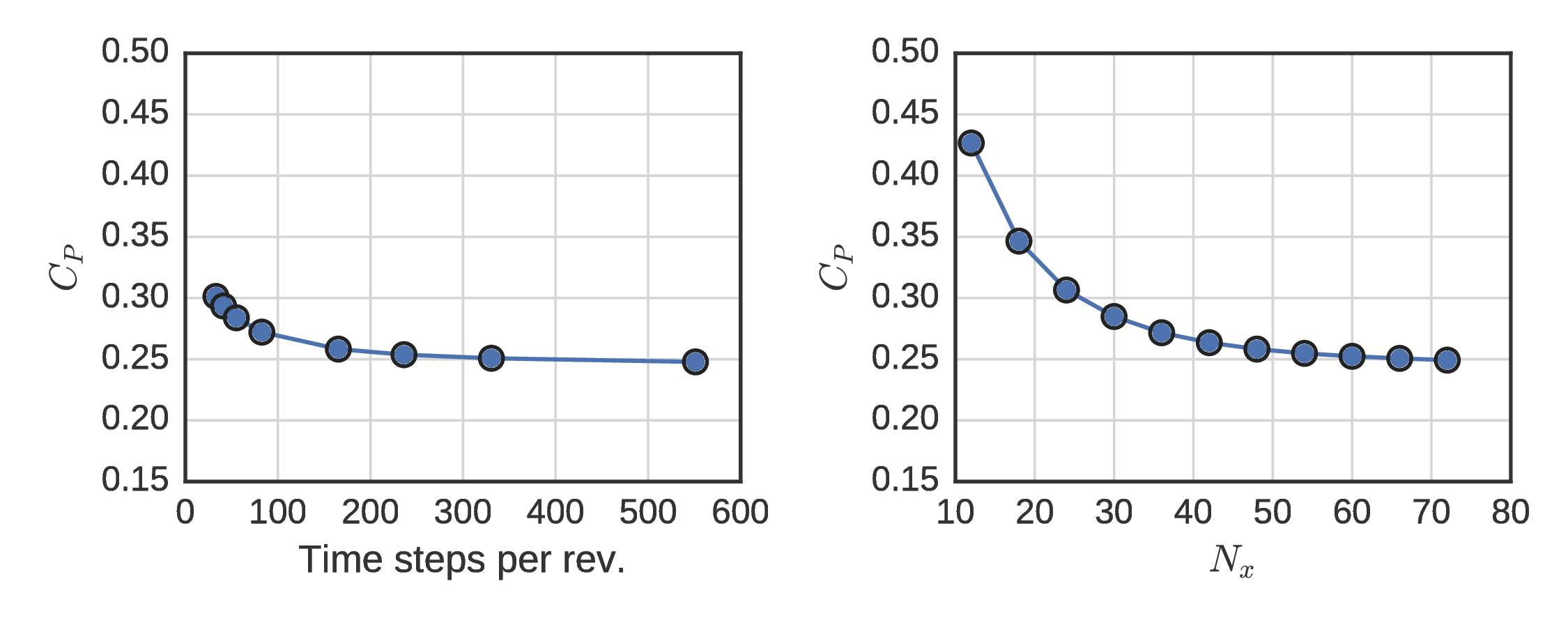
RM2
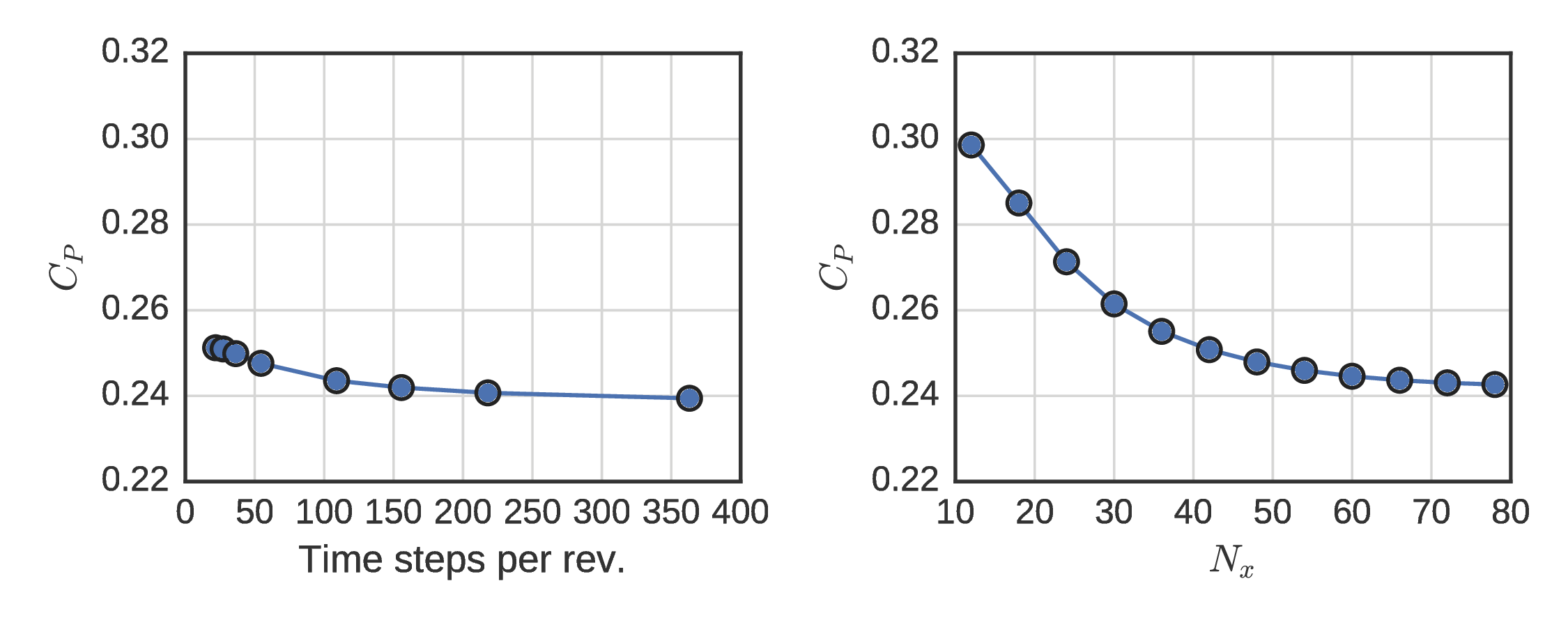
ALM performance¶
UNH-RVAT
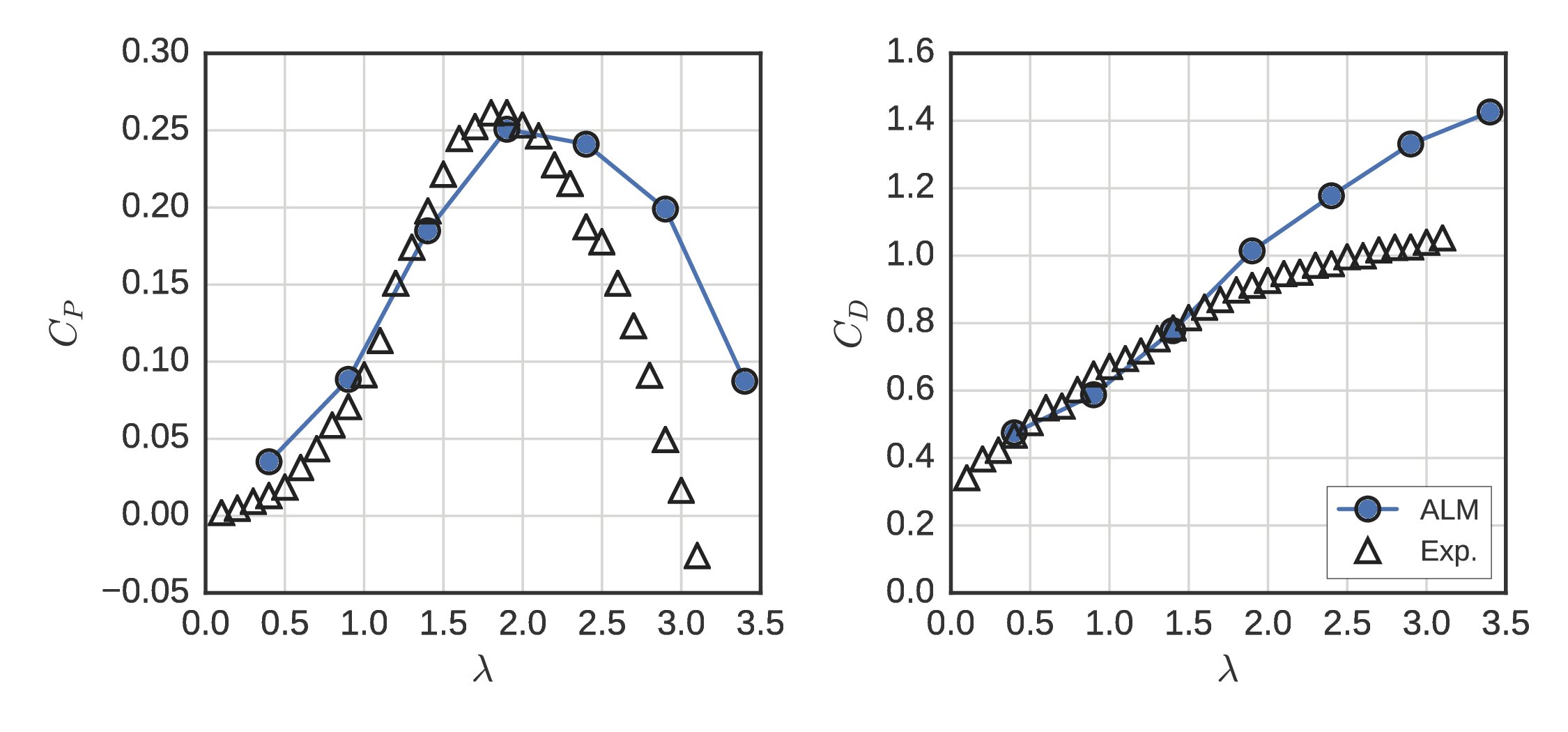
RM2
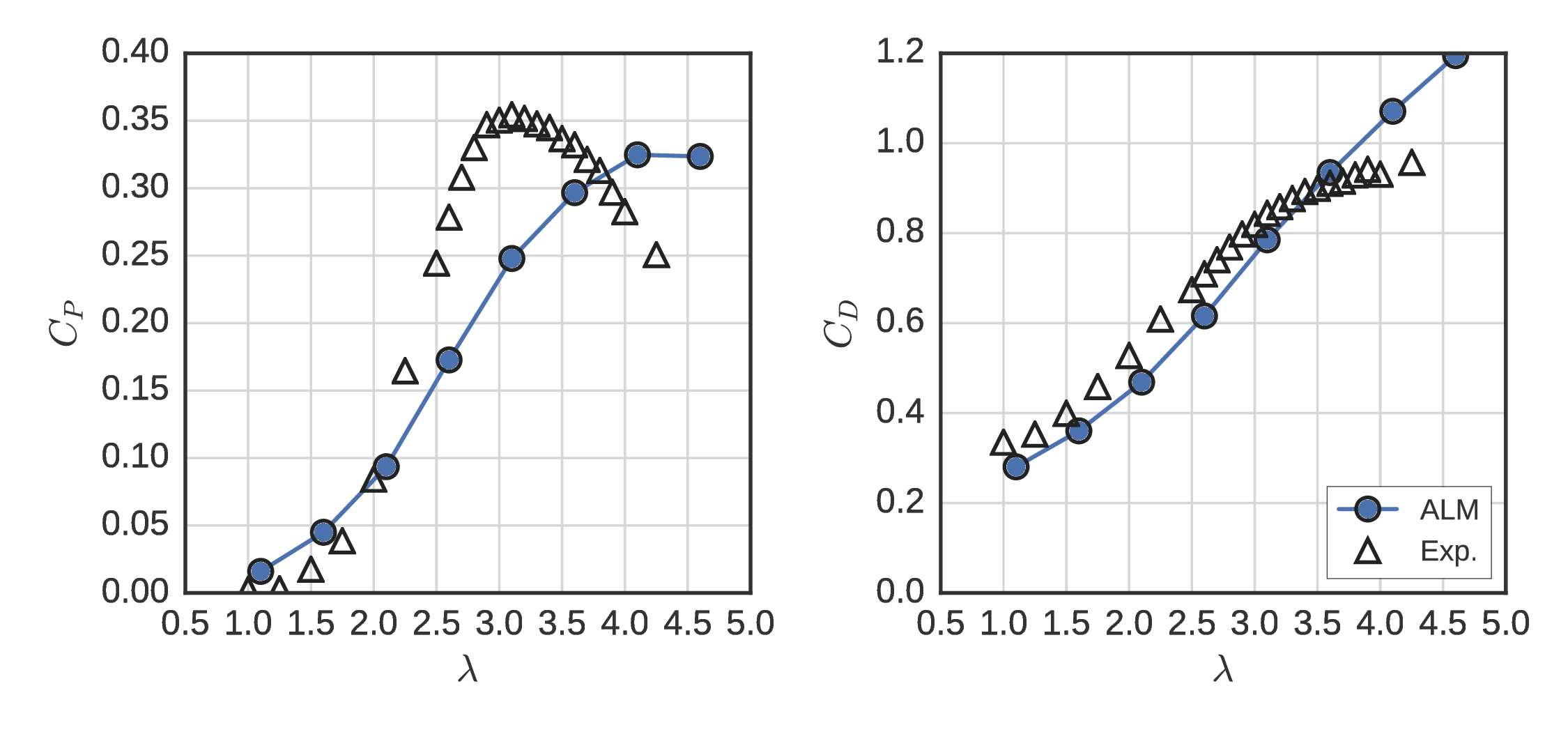
Actuator disk mean velocity at $x/D= 1$¶
Common streamwise force parameterization based on $C_D$
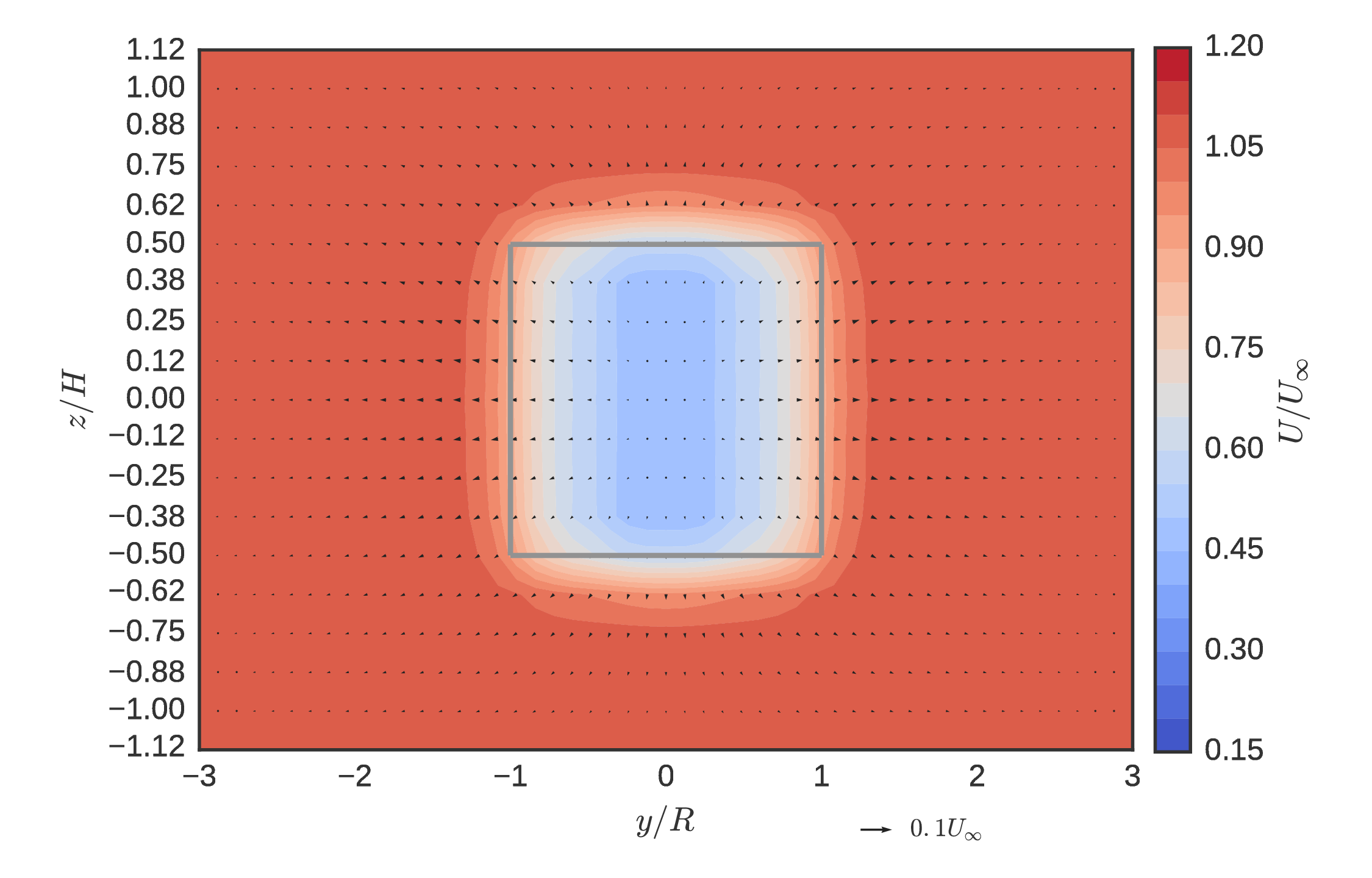
Small negative advection in all directions, very low turbulence, positive pressure gradient effect → ALM generates better IBCs for wake evolution
UNH-RVAT ALM LES¶
Default Smagorinsky sub-grid scale model
Computational expense up by $\sim 10^2$, still $\sim 10^2$ lower than BR RANS
Conclusions (I)¶
- Developed an automated turbine test bed and two 1 m scale turbine models
- High solidity UNH-RVAT and medium/low solidity RM2
- Produced 3 open performance and near-wake datasets
- Near-wake streamwise recovery dominated by vertical advection
- $Re$-independence at $Re_D \sim 10^6$ or $Re_c \sim 10^5$
- Guidelines for physical model scaling
- Blade-resolved RANS can postdict some results in 3-D
- Uncertainty w.r.t. turbulence model choice
- Too expensive for arrays
Conclusions (II)¶
Developed new open-source ALM library for OpenFOAM
- Fills gap between low- and high-fidelity modeling
- Retains Navier–Stokes description
- Reduce computational effort (not including meshing):
import pandas as pd
data = pd.Series()
data["ALM (3-D LES)"] = 10.0
data["ALM (3-D RANS)"] = 0.1
data["BR CFD (3-D)"] = 10**3
data["BR CFD (2-D)"] = 0.1
with sns.plotting_context(font_scale=3) \
and plt.rc_context({"axes.formatter.limits": (-1, 1),
"axes.formatter.use_mathtext": True}):
fig, ax = plt.subplots(figsize=(11, 2.5))
data.plot(ax=ax, kind="barh", logy=False, rot=0)
ax.set_xlabel("CPU hours per simulated second (approx.)")
plt.show()
- Performance predictions close to 3-D B-R RANS at optimal $\lambda$
- Wake predictions much better than AD, except low turbulent transport in LES
- Promising for future development → Improves with turbulence modeling
Future work¶
- 2-D blade-resolved RANS for relative optimization
- Investigate wake further downstream
- Compute streamwise derivatives and overall recovery rate
- Compare with blade-resolved CFD and ALM
- Vortex breakdown (PIV?) and SGS model selection
- ALM validation against multi-CFT (small array) experiments
Future work: VAT with free surface¶
Acknowledgments¶
